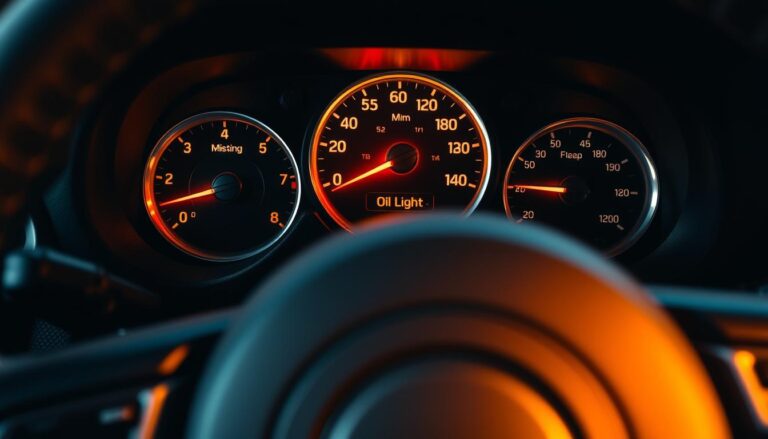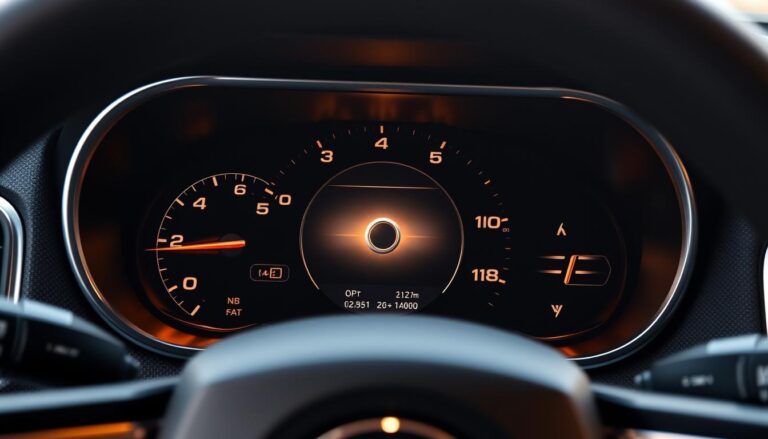Rapid cooling system noise can signal a simple duty-cycle response or an underlying mechanical issue. Even well-maintained vehicles show wear over time, and a loud cooling fan while the engine is running often points to parts that need attention. This guide helps you view symptoms in context and avoid needless parts swaps.
Listen and watch for clear signs across belts, brakes, and driveline. Learn when full blast fan speed is normal after a hot soak or heavy load, and when persistent noise suggests a deeper problem that could lead to overheating.
We outline quick checks you can perform at the curb, safety steps if gauges climb, and how cooling duty cycles behave at idle, in traffic, and on the highway. By following a stepwise plan you can confirm the issue, save time, and pick the right fix without needless expense.
Key Takeaways
- Identify normal high-speed fan operation versus abnormal fan noise.
- Perform simple visual and auditory checks before buying parts.
- Watch gauges and warning lights; reduce engine strain if needed.
- Understand cooling duty cycles at idle, traffic, and cruise speeds.
- Prioritize safety and stepwise diagnostics to avoid misdiagnosis.
Understanding Why Your Jeep’s Cooling Fan Gets So Loud
A loud, continuous fan blast typically means the cooling logic is compensating for higher-than-normal engine temperature.
What “fan on full blast” means for a running engine: the system commands high speed to shed heat after a hot shutdown, steep climb, or extended idling in high ambient degrees. This surge should drop off with time as temperature falls.
Modern cooling controls raise speed when sensors detect higher coolant temp or heavy AC condenser load. If the roar stays constant, the system may be fighting restricted air flow or a coolant-side restriction rather than normal brief bursts.
Wrangler vs. Grand Cherokee basics
Both vehicles share core parts: radiator, thermostat, water pump, shrouded fan, and control logic. Packaging differs a bit, but the root causes—clogged filter, debris, faulty motor, low coolant, stuck thermostat, or bad clutch—apply to each model.
Check whether the sound follows engine RPM or vehicle speed; that view helps isolate fan or driveline issues.
- If loudness rises with speed more than RPM, look at tires, driveline, or aerodynamics.
- Debris in front of the radiator reduces air flow and forces higher fan duty cycles.
- Persistence of noise long after shutdown is a strong clue of a real issue.
| Symptom | Likely Cause | Quick Check |
|---|---|---|
| Persistent high-speed fan | Restricted airflow or low coolant | Inspect grille, radiator fins, coolant level |
| Noise tracking RPM at idle | Fan motor, clutch, or belt issue | Listen with hood open at idle (safe distance) |
| Noise rising with vehicle speed | Driveline or aerodynamic source | Test on road at steady speeds |
My Jeep Wrangler Fan So Loud: Common Causes and How to Pinpoint Them
Start by isolating common causes that force the cooling to run at high speed and create persistent noise.
Airflow restriction: A clogged air filter or blocked grille cuts intake air. Replace a dark, oily element and clear leaves or sand from the airbox to restore proper flow.
Debris and blade imbalance: Dirt, twigs or leaves on the blades or inside the shroud cause extra vibration and odd noises. With the engine off, remove obstructions and check for cracked plastic or loose fasteners.

Faulty motor or clutch: A worn motor shows rough whine or scraping; a stuck clutch keeps the fan at near-max RPM. Inspect for wobble at the hub and listen for electrical or bearing sounds.
Cooling system faults: Low coolant, a failing water pump, or a stuck thermostat raises engine temperature and drives longer cooling cycles. Check coolant level cold, scan for fluid residue, and watch the temperature gauge.
Not the fan? Belt squeal, humming from the differential, or transmission whining can mimic fan noises. Note whether noise follows engine RPM or vehicle drive speed to isolate the source.
| Symptom | Likely cause | Quick action |
|---|---|---|
| Persistent high-speed noise | Restricted air or low coolant | Inspect filter, grille, radiator fins; top coolant cold |
| Vibration or wobble | Debris on blades or bad motor bearings | Remove debris; check blade clearance and motor hub |
| Roar unchanged with temp | Locked fan clutch or electrical motor fault | Check hub play; test motor current or replace clutch |
| Noise tracks vehicle speed | Drivetrain or aero source | Test on road to compare rpm vs. drive speed |
Step-by-Step Troubleshooting and Fixes You Can Do Today
A few quick inspections often reveal why the cooling runs hard and sounds aggressive.
Quick checks in minutes
When the engine is cold, check the coolant level in the reservoir. Look through the grille for clogged radiator fins and debris blocking air flow.
Start the vehicle and watch the temperature gauge at idle and while you drive a short distance. Note if the gauge climbs fast or holds steady; that pattern narrows the cause.
DIY cleaning and parts to inspect
Clear visible debris: Remove leaves from the shroud and blades. Gently straighten bent radiator fins with a fin comb to restore proper airflow.
Replace a dirty air filter and inspect belts and tensioner for cracks or glazing. Worn belts can mimic fan noise and harm accessory drive performance.

When to stop driving and seek service
If the temperature gauge climbs rapidly, you smell hot coolant, or warning lights appear, park safely and shut the engine down.
“Stopping early prevents a small cooling problem from becoming an engine failure.”
| Check | What to look for | Action |
|---|---|---|
| Coolant level | Low reservoir or visible leaks | Top off cold, inspect hoses and clamps |
| Airflow paths | Leaves, bent fins, dirty filter | Clean shroud, straighten fins, replace filter |
| Belts & pulleys | Cracks, glazing, wobble | Replace belt/tensioner to reduce noise |
| Thermostat / pump | Slow warm-up or coolant seep | Test thermostat, check water pump for play |
After repairs, road-test under similar conditions and record time-to-temp and sound duration. For a deeper guide on diagnosing persistent cooling fan noise, see why the fan may run loud after.
Conclusion
Takeaway, finish diagnostics with a simple checklist that separates true cooling system faults from other driveline noises.
Inspect airflow and coolant first. Clear debris, replace a dirty filter, and check the motor or clutch if the fan causes persistent noise.
Log when the sound appears, outside degrees, and whether it follows engine RPM or vehicle speed. That log helps isolate whether the issue lives in the cooling system or elsewhere on the vehicle.
Prioritize easy fixes, escalate when tests point to a failed part, and keep this guide among your saved posts. Timely checks prevent heat-related problems and keep the grand cherokee and jeep grand running quietly.
FAQ
Why is the cooling fan running at full blast while the engine is idling?
Excessive fan speed at idle often means the engine control system senses high temperature or poor airflow. Common triggers include low coolant level, a faulty thermostat, restricted radiator fins, or a failing temperature sensor. Check coolant level, inspect the radiator for debris, and monitor the dash temperature gauge. If those look normal, have the temperature sensor and fan relay tested.
Could a clogged air filter make the fan work harder and louder?
Yes. A clogged air filter restricts airflow through the engine bay and can raise under-hood temperatures, prompting the fan to run more often or faster. Replace or clean the air filter and confirm free airflow around the radiator and condenser to reduce fan load and noise.
How can debris in the fan blades cause vibration and noise?
Leaves, twigs, and dirt caught in the blades or shroud create imbalance, which leads to rattling or buzzing at speed. Safely inspect the fan area with the engine off and remove foreign material. Bent blades or a damaged shroud should be repaired or replaced to stop the noise and prevent further damage.
What are signs the fan motor itself is failing?
A failing motor may run intermittently, make grinding or whining noises, or run at unusually high speed. You might notice the fan not activating when the engine gets hot or running constantly. If testing shows inconsistent voltage or excessive current draw, replace the fan motor or assembly.
Can cooling system issues like low coolant or a bad water pump make the fan louder?
Yes. Low coolant reduces the system’s ability to carry heat away, forcing the fan to compensate. A failing water pump or stuck thermostat will also raise temperatures and increase fan duty. Inspect coolant level, look for leaks, check the thermostat, and test pump operation to diagnose the root cause.
What is a fan clutch and how does a stuck clutch affect noise?
A fan clutch engages and modulates fan speed on mechanically driven fans. If it sticks engaged, the fan spins at high speed constantly, producing loud noise and reducing fuel efficiency. A stuck clutch needs replacement; inspect for wobble or oil leakage as indicators of failure.
How do I tell if the noise is from the fan or another component like a belt or differential?
Narrow the source by observing when the noise occurs. Fan noise increases with engine temperature and often changes with engine RPM. Belt squeal happens during startup or under load and varies with RPM regardless of coolant temp. Humming from drivetrain components often changes with vehicle speed but not engine temp. Visual inspection and test drives can isolate the source.
What quick checks can I do in minutes to rule out easy fixes?
Park on level ground, let the engine cool, then check coolant level, look for obvious leaks, inspect the radiator and condenser for debris, and examine belts for wear. With the engine cold, gently spin the fan by hand (if accessible) to feel for binding. These checks catch many simple causes of loud fan operation.
Which DIY cleaning and parts inspections are safe and effective?
Safe DIY tasks include replacing the air filter, clearing leaves from radiator fins, cleaning the fan shroud, and checking belt tension and condition. Use a soft brush and low-pressure water to clean fins. Avoid working near a running fan and follow service manual torque and safety guidance when removing components.
When should I stop driving and take the vehicle to a shop?
Stop and seek service immediately if the temperature gauge climbs into the red, you see steam or coolant puddles, or the engine loses power. Persistent high fan speed with warning lights, visible coolant leaks, or overheating at idle are signs of a serious cooling-system failure that can cause engine damage.
Are there shared cooling system basics between Wrangler and Grand Cherokee models?
Yes. Both platforms use similar principles: a radiator, coolant, water pump, thermostat, sensors, and electric or clutch-driven fans. Symptoms and common failures — low coolant, clogged radiator, bad thermostat, or failed fan motor — apply to both, though component layout and service procedures differ by model and engine option.


